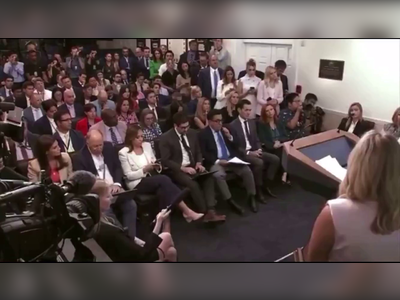
On election eve, the state of the US economy is a blurry one
From certain angles, the nation’s economic picture looks like a healthy one.
But the scene is being photo-bombed by an unsightly intruder: Chronically high inflation. Surging prices are straining family budgets and inflicting hardship on the most economically disadvantaged households. What’s more, the Federal Reserve’s drive to tame inflation through much higher interest rates is raising the risk of a recession by next year.
With voting underway in the midterm congressional elections that culminate next week, many Americans are gloomy about the outlook for the economy and their own finances — encouraging news for Republicans who hope to regain control of Congress and ominous news for President Joe Biden’s congressional Democrats. A poll conducted in early October by The Associated Press-NORC Center for Public Affairs Research found that 46% of people felt their personal financial situations were poor, up from 37% who said so in March.
America’s economy is in a confusing place 2½ years after COVID-19 upended business as usual. The brief but deep recession that erupted in the spring of 2020 was swiftly followed by an explosive recovery that overwhelmed global supply chains, causing shortages of goods and labor and fueling price pressures that have yet to ebb. What remains is an unusual blend of crushing inflation and a robust job market.

“The data,” said economist Megan Greene of the Kroll Institute, “is all over the map.’’
Many workers have received decent pay raises from employers who are desperate to attract and keep staffers. But higher prices are wiping out those pay gains. Adjusted for inflation, hourly pay fell 3% in September from a year earlier — the 18th straight monthly drop.
“Wage growth isn’t keeping pace,” Greene said. “It’s great that people have jobs. But their standards of living are being whittled by inflation.’’
Here’s a closer look at the economy’s vital signs, which are sending mixed signals to policymakers, businesses, forecasters — and voters:
THE OVERALL ECONOMY
Perhaps no economic barometer has been as head-scratching as the gross domestic product — the economy’s total output of goods and services. After surging 5.9% last year, the best mark since 1984, GDP fell into a funk in the first half of this year. It shrank at a 1.6% annual rate from January through March and then by 0.6% from April through June.
The first-half economic contraction was caused by factors that didn’t really reveal much about the health of the underlying economy. The decline was driven by a drop in companies’ inventories, a cyclical development that often reverses itself soon after, and a surge in imports, which reflected Americans’ keen appetite for foreign goods.
Last week, the government reported that GDP returned to growth in the July-September quarter, expanding at a solid 2.6% annual rate.
Yet the new picture wasn’t entirely cause for celebration. Consumer spending, which accounts for about 70% of U.S. economic activity, weakened last quarter: It rose at just a 1.4% annual rate, down from a 2% rate in the April-June period.

The entire third-quarter increase in GDP could be attributed to a jump in exports and lower imports, which together added nearly 2.8 percentage points of growth. That performance isn’t likely to be repeated. A stronger dollar has made American goods pricier overseas. And Russia’s war against Ukraine has contributed to a weakening global economy and lower demand for U.S. goods.
“If you look under the hood on those third-quarter figures,” Greene said, “it suggests that it wasn’t that strong, and we can’t expect it to continue.”
The economic outlook is also darkening as the Fed steadily jacks up interest rates. Since March, the central bank has raised its benchmark rate five times, including three straight hefty three-quarter-point hikes. It’s expected to do so again on Wednesday and in December.
The Fed’s policymakers have been aiming for a “soft landing” — raising rates enough to slow growth and bring inflation toward its 2% annual target without triggering a recession in the process. Most economists, though, doubt it can be done. They foresee a recession beginning sometime in 2023.
INFLATION
One reason for widespread skepticism about the Fed’s ability to stick a soft landing is that inflation is proving harder to defeat than policymakers had expected. The result is that more and larger rate hikes than originally envisioned will likely be required.

In September, the government’s consumer price index rose a higher-than-expected 0.4% from August and 8.2% from a year earlier. Worse, so-called core inflation, which strips out volatile food and energy costs to better assess price pressures, climbed 6.6% from a year earlier. That was the biggest such jump in 40 years.
What’s more, high inflation is hardly confined to the United States. In the 19 countries that share the euro currency, for example, prices soared 9.9% in September from a year earlier. The Russian invasion of Ukraine has driven up energy prices and disrupted food supplies.
In the United States, inflation has not only stayed high but has broadened from the goods sector of the economy to the much larger service sector — a vast area that includes everything from air fares, auto insurance and medical care to hotel rates, apartment rents and restaurant meals. Problem is, the farther inflation spreads, the harder it is to control.
JOBS
The job market is the clear star of the American economy.
Employers have shrugged off surging prices, rising interest rates and fears of a coming recession and just kept hiring. After adding a record 6.7 million jobs last year, the economy has tacked on a robust monthly average of 420,000 so far this year. The unemployment rate in September, 3.5%, matched a half-century low.
Still, the employment market is cooling. Job gains have slowed for two straight months — to 263,000 in September from 315,000 in August and 537,000 in July.

Employers posted 10.7 million job openings in October, the government reported Tuesday. That was up from 10.3 million, though down from a peak of 11.9 million in March. By historical standards, those figures were uncommonly high: For 15 straight months, openings have topped 10 million, a level they had never reached before 2021.
Americans are also enjoying extraordinary job security. Employers are shedding a monthly average of fewer than 1.4 million workers — on pace to surpass last year for the fewest layoffs in government records dating to 2001. The job market, though, is expected to deteriorate as the Fed’s rate hikes begin to bite.
CONSUMERS
American consumers, the lifeblood of the economy, have proved resilient through the ups and downs of the COVID economy. Their spending has both driven a strong recovery and ignited inflationary pressures.
Though higher prices have sapped their spending power, and the federal relief checks of 2020 and 2021 are long gone, Americans have kept spending, though at a moderating pace. Consumer spending rose 0.3% from August to September, even after accounting for inflation, the government reported.
It isn’t certain that consumers can keep it up. They have collectively used up much of the savings they amassed during pandemic, though their finances are still relatively strong, and are increasingly turning to credit cards. The U.S. savings rate has declined.
“It’s clear that the economy is slowing,” Kroll’s Greene said. “The question is how quickly. And the other question is, at what point businesses and consumers feel like they need to retrench. And that’s more a question of psychology than it is of economics.”
For now, businesses and consumers have enough cash on hand to keep on spending. They don’t have to cut back right away:
“But they might do so anyhow because there’s all this talk of a downturn coming and given there’s so much uncertainty in the economy.”
HOUSING
The Fed’s rate hikes have already claimed a victim: America’s housing market is reeling under the strain of drastically higher mortgage rates.
The average rate on a 30-year fixed mortgage, which was just 3.14% a year ago, topped 7% last week for the first time since 2002. Sales of existing homes have fallen for eight straight months.
The GDP report showed that housing investment plunged at a 26% annual pace from July through September. And housing construction in September was down 8% from a year earlier.
Home prices are still rising, supported by a limited number of houses on the market. But price increases are decelerating. The S&P CoreLogic Case-Shiller index of home price in 20 U.S. cities rose 13% in August from a year earlier. Still, that marked a slowdown from a 16% year-over-year gain in July.
As higher mortgage rates continue to derail home sales, Oxford Economics predicts, “the news on housing is only going to get worse from here.”

MANUFACTURERS
America’s factories are still expanding. But the outlook is dimming.
A manufacturing index issued Tuesday by the Institute for Supply Management, an organization of purchasing managers, showed that factories have been growing for 29 straight months. Still, the index fell in October to its lowest level since May 2020, when the economy was still struggling under the weight of COVID-forced business shutdowns. New orders, new export orders and hiring all contracted.
Likewise, the government reported last week that orders for long-lasting manufactured goods (excluding the volatile transportation sector) fell 0.5% in September.
That report “does not bode well,” wrote Kathy Bostjancic, chief U.S. economist at Oxford Economics. Factory-produced goods will likely be weakened by the higher dollar and stagnant economies overseas.
Bostjancic warned that the U.S. economy will likely weaken in the October-December quarter and slide in recession in the first half of 2023.










